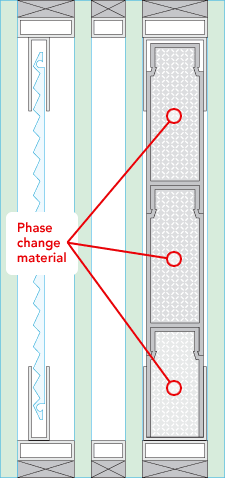 Natural sources of energy exist in adequate quantities on earth, but they are not always available when one needs them. How can daytime warmth be preserved till deep in the night or cool night temperatures maintained far into the day? One traditional means of doing this is to exploit the thermal storage capacity of solid materials, such as timber, stone, bricks or concrete. But these materials have a short threshold for thermal storage; in less than 4hours the heat will transfer into the building adding to the interior temperature when it is least appropriate, making air conditioning fix the problem.
Natural sources of energy exist in adequate quantities on earth, but they are not always available when one needs them. How can daytime warmth be preserved till deep in the night or cool night temperatures maintained far into the day? One traditional means of doing this is to exploit the thermal storage capacity of solid materials, such as timber, stone, bricks or concrete. But these materials have a short threshold for thermal storage; in less than 4hours the heat will transfer into the building adding to the interior temperature when it is least appropriate, making air conditioning fix the problem.
In an attempt to conserve energy and reduce dependency on fossil fuels, it has become necessary to seek effective means of reducing peaks in power consumption and to shift portions of the load from periods of maximum demand. The development of improved means of thermal storage is thus a very important aspect of energy conservation in buildings.
The utilisation of phase change materials (PCMs) in active and passive solar buildings has been subject to considerable interest since the first reported application in the 1940s. The appeal of PCMs is that they can store heat energy in a latent, leading to greater heat storage capacity per unit volume than that of conventional materials. As the ambient temperature rises, the chemical bonds within the PCM break up as the material changes phase from solid to liquid. The phase change is a heat-seeking (endothermic) process and therefore, the PCM absorbs heat. As the environment cools down, the PCM will return to solid phase and reject the heat it had absorbed.
PCM core of GlassX utilises Salt Hydrates that are hermetically sealed in clear polycarbonate containers. This PCM core has a much greater latent thermal storage capacity (thermal mass). To be exact up to 376btu/ft2 of latent thermal storage, which is on average 8-14 hours latent storage on a warm summer day. This allows the solar heat to be stored until night-time temperatures fall, in affect reducing average interior room temperatures by between 4 °C and 12°C making less use of air conditioning as well as off setting peak demand for energy on Cooling Degree Days.
Conversely, in the winter or Heating Degree Days, the GlassXPrism will minimize the heat energy reflected (g-value), thereby maximizing solar gains to charge up the GlassX PCM core during the day, which it then radiates out at night as the PCM returns to solid phase and reject the heat it had absorbed . This creates an average reduction of Heating Load of a building by 150-200 kWh/m2 per year on Heating Degree Days.
The PCM in GlassX is a passive form of thermal storage, it uses no electronic or moving parts and there is no maintenance. The GlassX PCM core is guaranteed for 100 years.
Further reading
PCM Latent Thermal Storage Unit– Heating and Cooling without Energy Consumption
